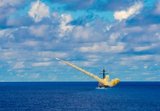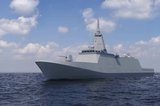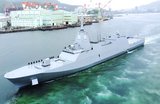Kongsberg, Diehl, MBDA to develop supersonic strike missile for Germany and Norway
The 3SM Tyrfing will be a long-range, manoeuvrable supersonic strike missile. (Photo: Kongsberg)
Norway's Kongsberg Defence & Aerospace, plus German companies Diehl Defence and MBDA have joined forces to develop a supersonic strike missile, known as 3SM Tyrfing (a magic sword in Norse mythology), for Germany and Norway.
The project will see the development of a long-distance, manoeuvrable supersonic strike missile.
The 3SM Tyrfing agreement was announced in November last year when the programme entered preliminary development. The effort needed further investment, and the companies involved have now entered an official partnership agreement.
The weapon was slated to succeed the Naval Strike Missile (NSM) currently in use on Norwegian naval ships starting in 2035, with subsequent deployment anticipated with the German Navy. Germany was expected to announce its plans for commissioning the 3SM Tyrfing later this year.
Although specific technical or performance specifications of the 3SM remained undisclosed, an illustrative concept unveiled by the Norwegian MoD and Kongsberg last year suggested that the missile will harness advanced solid-fuel ramjet propulsion, showcased through the collaborative Norwegian/US Tactical High-speed Offensive Ramjet for Extended Range (THOR-ER) initiative.
Norway and Germany’s armed forces, as well as their respective research organisations, will also work with the three companies.
“As we have seen over the last two years, stand-off weapons are crucial for credible deterrence and defence. Joining forces between our companies will strengthen the Norwegian, German and European armed forces, improving the defence of our home nations,” Thomas Gottschild, managing director of MBDA Deutschland, said.
Related Equipment in Defence Insight
More from Naval Warfare
-
![Mitsubishi eyes future with Australia’s Mogami selection]()
Mitsubishi eyes future with Australia’s Mogami selection
With Australia’s selection of the Mogami-class for Project Sea 3000, Mitsubishi is investigating local production in the next decade as potential export opportunities emerge.
-
![Thales’ new Sonar 76Nano could equip UK Royal Navy on anti-submarine warfare missions]()
Thales’ new Sonar 76Nano could equip UK Royal Navy on anti-submarine warfare missions
The new sonar is designed to equip uncrewed underwater vessels, with the potential to be used by the Royal Navy for its Atlantic Bastion and Atlantic Net missions.
-
![Hanwha wins Australian government approval to increase its stake in Austal]()
Hanwha wins Australian government approval to increase its stake in Austal
The contract would mean the two shipbuilders can collaborate strategically and enhance shipbuilding capabilities in Western Australia.






















